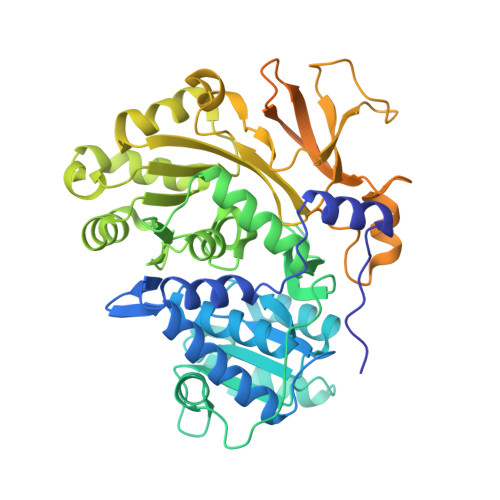Non-nucleoside inhibitors of BasE, an adenylating enzyme in the siderophore biosynthetic pathway of the opportunistic pathogen Acinetobacter baumannii.
Neres, J., Engelhart, C.A., Drake, E.J., Wilson, D.J., Fu, P., Boshoff, H.I., Barry 3rd, C.E., Gulick, A.M., Aldrich, C.C.(2013) J Med Chem 56: 2385-2405
- PubMed: 23437866
- DOI: https://doi.org/10.1021/jm301709s
- Primary Citation of Related Structures:
3U16, 3U17 - PubMed Abstract:
Siderophores are small-molecule iron chelators produced by bacteria and other microorganisms for survival under iron limiting conditions such as found in a mammalian host. Siderophore biosynthesis is essential for the virulence of many important Gram-negative pathogens including Acinetobacter baumannii, Klebsiella pneumoniae, Pseudomonas aeruginosa, and Escherichia coli. We performed high-throughput screening against BasE, which is involved in siderophore biosynthesis in A. baumannii, and identified 6-phenyl-1-(pyridin-4-ylmethyl)-1H-pyrazolo[3,4-b]pyridine-4-carboxylic acid 15. Herein we report the synthesis, biochemical, and microbiological evaluation of a systematic series of analogues of the HTS hit 15. Analogue 67 is the most potent analogue with a KD of 2 nM against BasE. Structural characterization of the inhibitors with BasE reveals that they bind in a unique orientation in the active site, occupying all three substrate binding sites, and thus can be considered as multisubstrate inhibitors. These results provide a foundation for future studies aimed at increasing both enzyme potency and antibacterial activity.
Organizational Affiliation:
Center for Drug Design, Academic Health Center, University of Minnesota , Minneapolis, Minnesota 55455, USA.


















